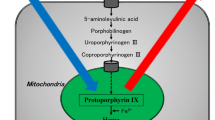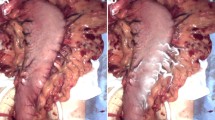Abstract
Background
The aim of this study was to evaluate the efficacy of using matrix metalloproteinase-2 (MMP-2) and matrix metalloproteinase-9 (MMP-9)-cleavable ratiometric activatable cell-penetrating peptides (RACPPs) conjugated to Cy5 and Cy7 fluorophores to accurately label pancreatic cancer for fluorescence-guided surgery (FGS) in an orthotopic mouse model.
Methods
Orthotopic mouse models were established using MiaPaCa-2-GFP human pancreatic cancer cells. Two weeks after implantation, tumor-bearing mice were randomized to conventional white light reflectance (WLR) surgery or FGS. FGS was performed at far-red and infrared wavelengths with a customized fluorescence-dissecting microscope 2 h after injection of MMP-2 and MMP-9-cleavable RACPPs. Green fluorescence imaging of the GFP-labeled cancer cells was used to assess the effectiveness of surgical resection and monitor recurrence. At 8 weeks, mice were sacrificed to evaluate tumor burden and metastases.
Results
Mice in the WLR group had larger primary tumors than mice in the FGS group at termination [1.72 g ± standard error (SE) 0.58 vs. 0.25 g ± SE 0.14; respectively, p = 0.026). Mean disease-free survival was significantly lengthened from 5.33 weeks in the WLR group to 7.38 weeks in the FGS group (p = 0.02). Recurrence rates were lower in the FGS group than in the WLR group (38 vs. 73 %; p = 0.049). This translated into lower local and distant recurrence rates for FGS compared to WLR (31 vs. 67 for local recurrence, respectively, and 25 vs. 60 % for distant recurrence, respectively). Metastatic tumor burden was significantly greater in the WLR group than in the FGS group (96.92 mm2 ± SE 52.03 vs. 2.20 mm2 ± SE 1.43; respectively, χ 2 = 5.455; p = 0.02).
Conclusions
RACPPs can accurately and effectively label pancreatic cancer for effective FGS, resulting in better postresection outcomes than for WLR surgery.



Similar content being viewed by others
References
Bouvet M, Hoffman RM. Glowing tumors make for better detection and resection. Sci Transl Med. 2011;3(110):110fs110.
Nguyen QT, Tsien RY. Fluorescence-guided surgery with live molecular navigation—a new cutting edge. Nat Rev Cancer. 2013;13(9):653–62.
Kaushal S, McElroy MK, Luiken GA, et al. Fluorophore-conjugated anti-CEA antibody for the intraoperative imaging of pancreatic and colorectal cancer. J Gastrointest Surg. 2008;12(11):1938–50.
McElroy M, Kaushal S, Luiken GA, et al. Imaging of primary and metastatic pancreatic cancer using a fluorophore-conjugated anti-CA19-9 antibody for surgical navigation. World J Surg. 2008;32(6):1057–66.
Hiroshima Y, Maawy A, Metildi CA, et al. Successful fluorescence-guided surgery on human colon cancer patient-derived orthotopic xenograft mouse models using a fluorophore-conjugated anti-CEA antibody and a portable imaging system. J Laparoendosc Adv Surg Tech A. 2014;24(4):241–7.
Metildi CA, Kaushal S, Lee C, et al. An LED light source and novel fluorophore combinations improve fluorescence laparoscopic detection of metastatic pancreatic cancer in orthotopic mouse models. J Am Coll Surg. 2012;214(6):997–1007.e2.
Metildi CA, Kaushal S, Luiken GA, Talamini MA, Hoffman RM, Bouvet M. Fluorescently labeled chimeric anti-CEA antibody improves detection and resection of human colon cancer in a patient-derived orthotopic xenograft (PDOX) nude mouse model. J Surg Oncol. 2014;109(5):451–8.
Metildi CA, Kaushal S, Pu M, et al. Fluorescence-guided surgery with a fluorophore-conjugated antibody to carcinoembryonic antigen (CEA), that highlights the tumor, improves surgical resection and increases survival in orthotopic mouse models of human pancreatic cancer. Ann Surg Oncol. 2014;21(4):1405–11.
Tran Cao HS, Kaushal S, Metildi CA, et al. Tumor-specific fluorescence antibody imaging enables accurate staging laparoscopy in an orthotopic model of pancreatic cancer. Hepatogastroenterology. 2012;59(118):1994–9.
Kishimoto H, Urata Y, Tanaka N, Fujiwara T, Hoffman RM. Selective metastatic tumor labeling with green fluorescent protein and killing by systemic administration of telomerase-dependent adenoviruses. Mol Cancer Ther. 2009;8(11):3001–8.
Kishimoto H, Zhao M, Hayashi K, et al. In vivo internal tumor illumination by telomerase-dependent adenoviral GFP for precise surgical navigation. Proc Natl Acad Sci USA. 2009;106(34):14514–7.
Aguilera TA, Olson ES, Timmers MM, Jiang T, Tsien RY. Systemic in vivo distribution of activatable cell penetrating peptides is superior to that of cell penetrating peptides. Integr Biol. 2009;1(5-6):371–81.
Jiang T, Olson ES, Nguyen QT, Roy M, Jennings PA, Tsien RY. Tumor imaging by means of proteolytic activation of cell-penetrating peptides. Proc Natl Acad Sci USA. 2004;101(51):17867–72.
Nguyen QT, Olson ES, Aguilera TA, et al. Surgery with molecular fluorescence imaging using activatable cell-penetrating peptides decreases residual cancer and improves survival. Proc Natl Acad Sci USA. 2010;107(9):4317–22.
Olson ES, Aguilera TA, Jiang T, et al. In vivo characterization of activatable cell penetrating peptides for targeting protease activity in cancer. Integr Biol. 2009;1(5–6):382–93.
Savariar EN, Felsen CN, Nashi N, et al. Real-time in vivo molecular detection of primary tumors and metastases with ratiometric activatable cell-penetrating peptides. Cancer Res. 2013;73(2):855–64.
Technical Data Sheet, Fluorescent Imaging Agent MMPsense 680. http://www.perkinelmer.com/CMSResources/Images/44-73969TCH_NEV10126-MMPSense680-TD.pdf.
Katz MH, Takimoto S, Spivack D, Moossa AR, Hoffman RM, Bouvet M. A novel red fluorescent protein orthotopic pancreatic cancer model for the preclinical evaluation of chemotherapeutics. J Surg Res. 2003;113(1):151–60.
Bouvet M, Wang J, Nardin SR, et al. Real-time optical imaging of primary tumor growth and multiple metastatic events in a pancreatic cancer orthotopic model. Cancer Res. 2002;62(5):1534–40.
Fu X, Guadagni F, Hoffman RM. A metastatic nude-mouse model of human pancreatic cancer constructed orthotopically with histologically intact patient specimens. Proc Natl Acad Sci USA. 1992;89(12):5645–9.
Furukawa T, Kubota T, Watanabe M, Kitajima M, Hoffman RM. A novel “patient-like” treatment model of human pancreatic cancer constructed using orthotopic transplantation of histologically intact human tumor tissue in nude mice. Cancer Res. 1993;53(13):3070–2.
Troyan SL, Kianzad V, Gibbs-Strauss SL, et al. The FLARE intraoperative near-infrared fluorescence imaging system: a first-in-human clinical trial in breast cancer sentinel lymph node mapping. Ann Surg Oncol. 2009;16(10):2943–52.
Ishizawa T, Fukushima N, Shibahara J, et al. Real-time identification of liver cancers by using indocyanine green fluorescent imaging. Cancer. 2009;115(11):2491–504.
Stummer W, Pichlmeier U, Meinel T, et al. Fluorescence-guided surgery with 5-aminolevulinic acid for resection of malignant glioma: a randomised controlled multicentre phase III trial. Lancet Oncol. 2006;7(5):392–401.
Stiles BM, Bhargava A, Adusumilli PS, et al. The replication-competent oncolytic herpes simplex mutant virus NV1066 is effective in the treatment of esophageal cancer. Surgery. 2003;134(2):357–64.
Kishimoto H, Aki R, Urata Y, et al. Tumor-selective, adenoviral-mediated GFP genetic labeling of human cancer in the live mouse reports future recurrence after resection. Cell Cycle. 2011;10(16):2737–41.
van Dam GM, Themelis G, Crane LM, et al. Intraoperative tumor-specific fluorescence imaging in ovarian cancer by folate receptor-alpha targeting: first in-human results. Nat Med. 2011;17(10):1315–9.
Bloomston M, Zervos EE, Rosemurgy AS 2nd. Matrix metalloproteinases and their role in pancreatic cancer: a review of preclinical studies and clinical trials. Ann Surg Oncol. 2002;9(7):668–74.
Bramhall SR. The matrix metalloproteinases and their inhibitors in pancreatic cancer. From molecular science to a clinical application. Int J Pancreatol. 1997;21(1):1–2.
Maatta M, Soini Y, Liakka A, Autio-Harmainen H. Differential expression of matrix metalloproteinase (MMP)-2, MMP-9, and membrane type 1-MMP in hepatocellular and pancreatic adenocarcinoma: implications for tumor progression and clinical prognosis. Clin Cancer Res. 2000;6(7):2726–34.
Acknowledgment
This work was supported in part by grants CA132971 and CA142669 from the National Cancer Institute (to M.B. and AntiCancer, Inc.), T32 training grant CA121938 (to C.A.M.), training grant 5R25CA153915 and fellowship grant 1F30HL118998-01 (to C.N.F.), Burrough-Wellcome Fund CAMS and 5K08EB008122 from the National Institutes of Health (to Q.T.N.), and CA158448 from the National Cancer Institute (to R.Y.T.). The authors would also like to thank Elamprakash Savariar for synthesizing the ratiometric imaging agents and Paul Steinbach for surgical imaging support.
Author information
Authors and Affiliations
Corresponding author
Rights and permissions
About this article
Cite this article
Metildi, C.A., Felsen, C.N., Savariar, E.N. et al. Ratiometric Activatable Cell-Penetrating Peptides Label Pancreatic Cancer, Enabling Fluorescence-Guided Surgery, Which Reduces Metastases and Recurrence in Orthotopic Mouse Models. Ann Surg Oncol 22, 2082–2087 (2015). https://doi.org/10.1245/s10434-014-4144-1
Received:
Published:
Issue Date:
DOI: https://doi.org/10.1245/s10434-014-4144-1




